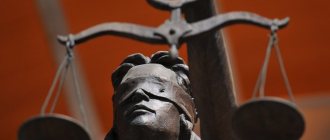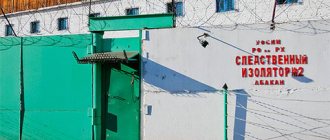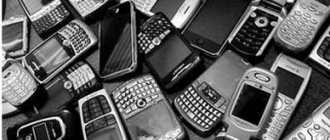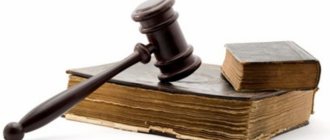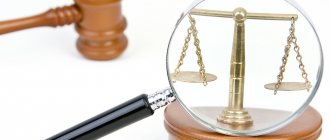Objects and classes of forensic examinations
Traditional forensic examination examines objects, specialists perform actions corresponding to the required class of criminal diagnostics, identify facts regarding the event under investigation, and submit a conclusion to the court.
The legal body analyzes the test results and expert conclusions, and then makes a fair verdict.
The science of “forensics” establishes the laws:
- mechanism of criminal action;
- collecting information about the event, criminals and instruments of crime;
- testing objects of crime;
- forming an evidentiary basis in order to determine the credibility of the guilt or innocence of suspects and prevent possible similar acts in the future.
The dynamics of the mechanics of a criminal act consists of:
✔️ subject of crime;
✔️ the object that the criminal’s actions are aimed at;
✔️ the way in which moral, material or physical damage was caused;
✔️ the result of breaking the law;
✔️ time and place of the criminal act;
✔️ conditions and circumstances in which the criminal acted.
Over time, the number of orders for forensic research increases, the number and variety of types and classes of examinations increases. Non-traditional forensic examinations are actively used, multi-object studies are carried out in a complex.
Examination of fibers, fibrous materials and products made from them
First of all, this type of forensic research helps to determine the identity of fabric particles found at the scene of events, establish the method of its manufacture (industrial, handicraft), as well as completeness (a jacket belt). Thanks to laboratory study of fabrics and their particles, it is possible to find out the causes and nature of damage and restore the original appearance of the product.
Let's consider this situation: criminals broke into an apartment and committed a robbery. A struggle ensued between them and the owners of the home. In the general confusion, one of the criminals caught the sleeve of his sweater on the door handle. As a result, part of the material came off the clothing and fell to the floor. The criminals fled, but left behind evidence. Based on the results of the material examination, it will be established that the piece of fabric found during the inspection of the scene belonged to a person wearing an industrial woolen sweater, color – gray. Then, when the suspect is detained or during a search of his apartment, the appropriate clothing will be found, which will ultimately serve as good evidence against him.
The concept of forensic examinations
Criminal examinations are typical studies aimed at obtaining competent and substantiated evidence.
The reliability of the results for the formation of the final examination document depends on the professionalism and experience of a specialist or group of specialists invited to conduct experiments and analysis. A qualified expert chooses classic and newfangled methods, applies the knowledge available in the arsenal, and uses reliable equipment.
Criminal examinations can be simple, in which case a single examiner is involved in the work. When the case is complicated, the events are separated in time, the incident concerns many participants and a mass of objects, then a group of multi-sphere specialists is assembled.
Forensic economic examinations
Their task boils down to assisting investigative and judicial authorities in solving crimes in the economic sphere (illegal entrepreneurship, falsification of financial documents, illegal banking activities, money laundering, etc. (Chapter 22 of the Criminal Code of the Russian Federation)). Includes forensic accounting and forensic merchandising examinations.
There are also independent types of forensic research. These include: forensic soil science, forensic video-phonographic examination, and road accident examination. Due to the high prevalence of road accidents, quite often it is necessary to resort to the services of experts specializing in the field of auto mechanics and other areas related to motor transport.
This type of research is aimed at studying factual data about the situation that has arisen, assessing the technical condition of transport, analyzing the driver’s actions, determining the speed of movement and much more. But the main task of the examination is to identify the culprit of the road accident.
The second basis for the classification of forensic research will be the frequency criterion. Accordingly, they are divided into primary and secondary. A re-examination may be required if the investigator has doubts about the reliability and validity of the conclusion of the initial study (for example, doubts about the competence of the specialist, the methods he uses, the use of certain equipment). This examination cannot be carried out by the same person or organization.
In accordance with the following criterion - by volume - forensic examinations can be divided into basic and additional. Unlike a repeated one, an additional one is carried out not to check the reliability of the study, but in order to pose new questions to the expert, and also if there is a need to transfer new materials for study.
Based on the number of specialists, forensic examinations are divided into individual (conducted by one person) and commission (conducted by several persons specializing in one industry, and appointed in special cases requiring a more objective and comprehensive study).
Forensic examinations are also divided into:
- homogeneous (specialists from the same industry participate);
- comprehensive: carried out by experts from different specialties or by one specialist with the necessary knowledge in different industries (most often, studies of this kind are used in the investigation of road accidents).
Types of forensic examinations
If after the initial research there are still doubts about the results obtained, a re-examination is prescribed. The identification of new objects and data, the provision of previously unknown documents and materials to the investigation often influences the revision of the conclusions made.
It is not easy to collect all the studies by species; the list of questions for experts is almost endless, the variety of objects for experiments/analytics is almost endless. However, it is necessary to decide on the types of criminal examinations.
Main types of forensic examinations:
Fingerprinting. Traces of fingers and palms on any surface of every object found at the scene of the event are identified and analyzed. Digital technologies and computer diagnostics make the work of experts easier and increase the credibility of the results.
Handwriting studies. Scrupulous work is carried out on signatures and notes, handwritten papers in order to identify the specific person who wrote the text. When a suicide is investigated, experts try to understand whether the person himself committed suicide or whether it was a provocation from the outside.
Portrait (gabitoscopy). All kinds of images of a person are collected (photos, videos, artistic drawings) in order to identify “pictures” with an individual, establish gender, age, race. Used in a wide range of investigations - theft, fraud, robbery.
Traceological. The traces left by objects or substances on surfaces are examined, the methods of their occurrence are identified, and the conditions for causing scars and tracks are assumed (traces can be left by people, animals, vehicles and other mechanical devices).
Forensic examination of human gait is an example of such research. Based on the location of the shoe marks, an experienced specialist will tell “who was here” - a woman or a man, the approximate age of the person, and his state of health. Features of gait can also indicate the character of the subject.
Technical and forensic documents. Tests are carried out on official and household papers that have stamps, impressions, and remarks.
The goal is to use all the documents presented to the investigation to establish how and on what equipment the protocol was executed (typewriter, computer, fax), and what the form was used to fill out (pen, pencil, ballpoint pen). These studies also answer the questions of a technical and forensic examination of a passport - whether the identity data is reliable, whether the indicated dates are accurate, whether the document is filled out correctly.
Forensic examination of money. Appointed in case of investigation of banknote fraud. In essence, the research belongs to the type of “technical-criminal testing of documents.”
Paper signs, securities, counterfeit money are inspected, and assumptions are made about the manufacturing methods and mechanism of counterfeits.
Examinations of damaged banknotes of the Russian Federation or foreign powers are performed pre-trial.
How long ago the document was created. Numerous forgeries/slanders/anonymous testimony force experts to work to find out whether there were any forgeries in the document, or whether the finished act was corrected. To do this, you need to determine the age of the original, original paper.
Forensic examination of documents
Another type of forensic research. Examination of documentation allows you to study methods of falsifying documents, restore their contents, if possible (in case of partial forgery), and determine the authenticity of documents.
Due to the fact that falsification of documents is quite closely related to the deliberate change of handwriting (for example, forging the signature of an official, manager or chief accountant of an organization), many people put forensic technical examination of documents on a par with handwriting and combine it under the common name - forensic research documents.
Classification of forensic examinations
Scientific and practical aspects divide all research into branches of knowledge and class (genus, type) in relation to subjects, objects and methods into classes.
There is no clear division, the studies are closely intertwined, but in general terms the class of forensic examinations includes traditional and non-traditional ones.
Traditional forensic examinations
The most common and popular are traditional criminal investigations.
The initial basis for such tests is the methodology of criminal techniques + the theory of criminal identification.
Basic traditional forensic examinations:
- forensic handwriting (the general technique of hand movements is analyzed, the character of the person writing the paper is determined);
- forensic authorship (the author of the text is determined from the manuscript or printout);
- forensic technical documents (it is established how the protocol was executed, what consumables were used, whether it is possible to reanimate the damaged document);
- forensic phototechnical (negatives and photographs are examined, shooting conditions and the location of printing of frames are identified, images are identified with specific persons);
- forensic-traceological (work is underway on displays, traces, tracks from feet, hands and even teeth at each object of study. Later, traces are identified with a living creature (person or animal) or inanimate object (tool, mechanism) that left the imprint of activity);
- forensic fingerprinting (work is carried out only with the fingers and palms of a person);
- forensic portrait (a person’s identity is determined from a photo of a person’s face or skull);
- forensic ballistic (all actions related to firearms and ammunition are carried out. It looks at where and how a specific “hot” object was used, the brand of weapon is identified by bullets and cartridges);
- judicial investigations in relation to bladed weapons (it is established whether a “cold” object could be an instrument of injury, to what extent the object is dangerous, how and by whom it was made);
- forensic phonoscopic examination (by the voice on the phonogram it is determined what gender/age/social group/intellectual abilities the person left the audio message).
- Not so long ago, methods of image analytics, achievements of cybernetics, physical and chemical developments, anthropological practices, and other new discoveries and tools began to be introduced into practice.
Non-traditional forensic examinations
Based on the scale and volume of research, there are basic and additional ones. If after the general examination there are still questions, test work is resumed to clarify the details.
More often, the same specialist who conducted the main ones is involved in additional experiments. But a third-party analyst may be appointed.
According to the number and composition of research experts, there are:
- sole workers (a specialist works alone);
- commissions (several employees of the same specialization are invited to work);
- complex (employees from different areas gather to carry out comprehensive experiments and draw the most competent conclusion).
For example: It is necessary to determine how the accident happened, who was involved, and whether the accident could have been avoided. A comprehensive - traceological + auto-technical examination is assigned.
Basic non-traditional forensic examinations:
Forensic examination of materials, substances and products (CEMVI). The goal is to recognize by the micronumber of particles which group the object of study belongs to.
This non-traditional criminal examination examines: paint materials/coatings, fibrous objects, petroleum products/fuels and lubricants, glass products/porcelain/faience/ceramics, metals/alloys, polymers/products made from them, drugs/psychotropic substances, perfumes/cosmetics.
CEMVI is a fairly new type of examination that analyzes particles of any substance left at any research object.
Deliver the material with microparticles in its original form. To do this, you need to know the rules for packaging each substance and not pollute the atmosphere with impurities (for example, when working with evidence of this kind, smoking, combing, and other similar actions are prohibited).
Forensic examination of materials, worked out by the best specialists, gives a chance to recognize facts/signs that are important for the investigation, to individualize the object, and to establish the class of belonging of the object under investigation.
Forensic engineering and technical examination can be:
- Forensic-autotechnical (the condition of the vehicle, the condition of the driver and pedestrian, traffic police mechanics are looked at);
- forensic-fire-technical (the source of the fire, the path of fire spread, the causes, the influence of natural phenomena on the situation are inspected);
- forensic electrical engineering (the causes of an accident in the network/equipment and the serviceability of the protection system are investigated);
- forensic explosives (the fact of an explosion is analyzed, explosive substances/devices are studied);
- forensic-construction-technical (the causes of collapses at a construction site are examined, the competence of construction and installation actions is established, the quality of materials corresponds to the cost);
- forensic engineering and technological (industrial safety, violation/compliance with technological processes of product manufacturing are studied);
- forensic-computer-technological (the performance of computers and peripheral equipment, networks is diagnosed.
The quality of the software is examined, the information base and magnetic media are studied).
Forensic medical examination is:

